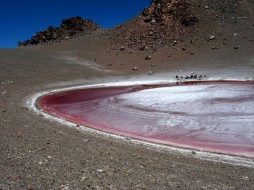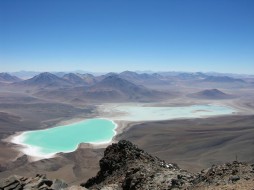From Earth to the Solar System: A lake at the top of the world
The highest volcanic lakes in the world are located in the Andes Mountains of South America. Their elevation and isolation make them some of the least understood lakes on Earth and excellent analogs for lakes that existed on Mars 3.5 billion years ago. Simba Lake, at an elevation of 5,872 meters in the Chilean Andes, is red because of algae that developed pigments to protect themselves against high UV radiation. They float in the water near the surface, not deep enough to use the water column as a natural protection. Astrobiologists working there study the impact of rapid climate change on lake habitat and life’s adaptability in an effort to understand the evolution of the early environments of both Mars and Earth. (Image Credit: High Lakes Project/NASA Astrobiology Institute/SETI CSC/NASA Ames Research Center)
Laguna Verde, at an elevation of 4,340 meters in the Bolivian Altiplano, embodies many of the qualities of an ancient Martian environment, including low average temperature, high-daily temperature variations, thin atmosphere, and both volcanic and hydrothermal geology. Astrobiologists are studying the impact of rapid climate change on these lakes and their ability to sustain life in a highly dynamic environment. Their results could shed light on the fate of life that may have arisen on Mars in the past and become extinct as the planet’s geology and climate evolved. (Image Credit: High Lakes Project/NASA Astrobiology Institute/SETI CSC/NASA Ames Research Center)
Posted: 14 June 2011
- Categories:





